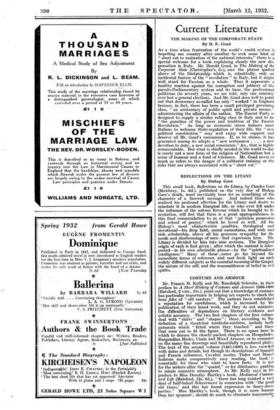COSTUME AND,ARMOUR
Mr. Francis M. Kelly and Mr.Bandolph Schwabe, in their preface to A Short History of Costume and Armour 1066-1800 (Batsford, 2 vols., 25s.), point out that a knowledge of costume has particular importance in helping art experts to cheek the bona fides of " old masters." The authors have established a reputation for carefulness, whieh is increased by the publication of their latest work, and they do not minimize the difficulties of dePendence on literary evidence and artistic accuracy. The two first chapters of the first voliane deal with "shirts" and "shapes" : these, according to the definition of a theatrical waidriffie-rnistreas, include body garments which " fitted where they touched " and thaw that were cut to fit the figure. There is no space here:in which to discuss the closely-packed chapters on Houpelades. B dian Modes, Chain and Mixed Armour, or to comment on the many fine drawings and beautifully reproduced plates. The text of the second volume (1485-1800) is less crowded with dates and:details, but though its descriptions of Spanish and French influences, Cavalier modes, Tudor and Stuhrt fashions make' comparatively easy reading; the book is essentially for those who want to know facts. It is not for the seekers after, the "quaint," or for dilettantes, panthig to inhale romantic atmosphere. • As Mr. Kelly sayS in his preface to Miss Dorothy Hartley's book, Mediaeval Cost:inn and Life (Botsford, 12s. " there has long existed a vast deal of half-baked Schwarmerei in connexion with the gored old times,' and this has found expression in fancy-dress parties." Miss Hartley's book, though it is more humaa than her sponsors', should do much to eliminate inaccuracies -from pageants, since, besides describing the costumes and paraphernalia of royalty, aristocracy, clergy, professionals, artizans and labourers, gives details and diagrams for the help of costume-makers. Unfortunately, the text makes abrupt reading, owing to the author's habit of crowding description and instruction into a single sentence. She is, at times, ambiguous, particularly in this sentence : " After the careful restrictions of religion and royalty, musicians are refreshingly loose, and may wear anything."



















































 Previous page
Previous page